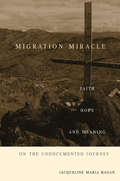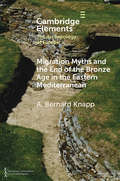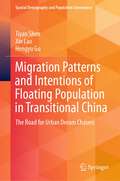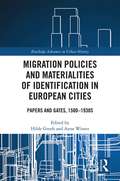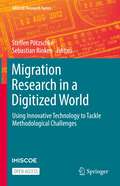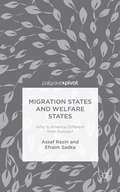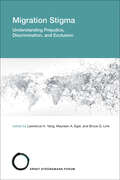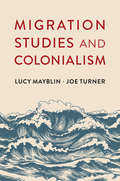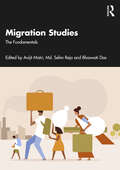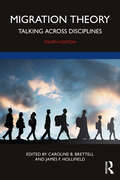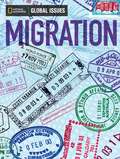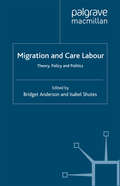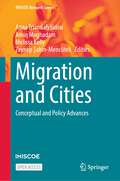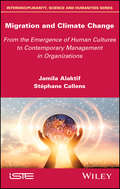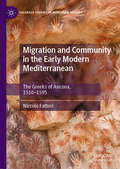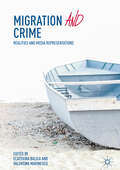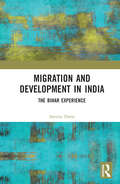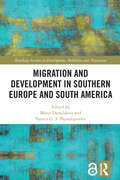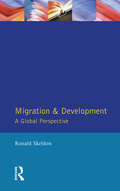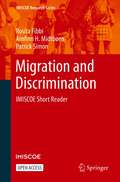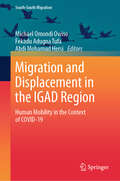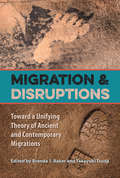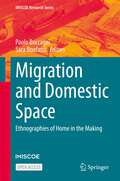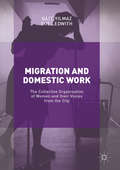- Table View
- List View
Migration Miracle: Faith, Hope, and Meaning on the Undocumented Journey
by Jacqueline Maria HaganSince the arrival of the Puritans, various religious groups, including Quakers, Jews, Catholics, and Protestant sects, have migrated to the United States. The role of religion in motivating their migration and shaping their settlement experiences has been well documented. What has not been recorded is the contemporary story of how migrants from Mexico and Central America rely on religion—their clergy, faith, cultural expressions, and everyday religious practices—to endure the undocumented journey. At a time when anti-immigrant feeling is rising among the American public and when immigration is often cast in economic or deviant terms, Migration Miracle humanizes the controversy by exploring the harsh realities of the migrants’ desperate journeys. Drawing on over 300 interviews with men, women, and children, Jacqueline Hagan focuses on an unexplored dimension of the migration undertaking—the role of religion and faith in surviving the journey. Each year hundreds of thousands of migrants risk their lives to cross the border into the United States, yet until now, few scholars have sought migrants’ own accounts of their experiences.
Migration Myths and the End of the Bronze Age in the Eastern Mediterranean (Elements in the Archaeology of Europe)
by A. Bernard KnappThis Element looks critically at migration scenarios proposed for the end of the Bronze Age in the eastern Mediterranean. After presenting some historical background to the development of migration studies, including types and definitions of migration as well as some of its possible material correlates, I consider how we go about studying human mobility and issues regarding 'ethnicity'. There follows a detailed and critical examination of the history of research related to migration and ethnicity in the southern Levant at the end of the Late Bronze Age (ca. 1200 BC), considering both migrationist and anti-migrationist views. I then present and critique recent studies on climatic and related issues, as well as the current state of evidence from palaeogenetics and strontium isotope analyses. The conclusion attempts to look anew at this enigmatic period of transformation and social change, of mobility and connectivity, alongside the hybridised practices of social actors.
Migration Patterns and Intentions of Floating Population in Transitional China: The Road for Urban Dream Chasers (Spatial Demography and Population Governance)
by Tiyan Shen Xin Lao Hengyu GuThis book investigates domestic migration and migration intentions in China from the individual, city, and provincial levels. Since the 1990s, accompanying the rapid urbanization, an important feature of China’s social transition is its large-scale interregional migration, which has reshaped China’s economic geography and population distribution and greatly affected the socio-economic development. The floating population, migrants working and living in the destination cities without local hukou, have aroused wide public concern in the past decades. Based on China’s national population census data and China Migrants Dynamic Survey data, this book comprehensively employs statistical analysis, spatial analysis, network analysis, econometric and spatial econometric methods to analyze the spatial pattern and influencing mechanism of internal migration and migration intentions of floating population from different levels and different perspectives. The research results of this book have significant policy implications for the urban governance on the floating population. The novelty of this book is that it comprehensively investigates domestic migration and migration intentions from the individual, city and provincial levels, combining their spatial patterns and network structures. It not only provides a wealth of case studies for domestic migration research in China, but also broadens the research scope of spatial demography by employing new methods of spatial econometrics (such as MGWR and ESF). This book is suitable for undergraduates and graduates majoring in Human Geography, Regional Economics, Urban Planning and Urban Governance, as well as related researchers and practitioners.
Migration Policies and Materialities of Identification in European Cities: Papers and Gates, 1500-1930s (Routledge Advances in Urban History)
by Anne Winter Hilde GreefsThis book focusses on the instruments, practices, and materialities produced by various authorities to monitor, regulate, and identify migrants in European cities from the sixteenth to the twentieth centuries. Whereas research on migration regulation typically looks at local policies for the early modern period and at state policies for the contemporary period, this book avoids the stalemate of modernity narratives by exploring a long-term genealogy of migration regulation in which cities played a pivotal role. The case studies range from early modern Venice, Stockholm and Constantinople, to nineteenth- and twentieth-century port towns and capital cities such as London and Vienna.
Migration Research in a Digitized World: Using Innovative Technology to Tackle Methodological Challenges (IMISCOE Research Series)
by Steffen Pötzschke Sebastian RinkenThis open access book explores implications of the digital revolution for migration scholars’ methodological toolkit. New information and communication technologies hold considerable potential to improve the quality of migration research by originating previously non-viable solutions to a myriad of methodological challenges in this field of study. Combining cutting-edge migration scholarship and methodological expertise, the book addresses a range of crucial issues related to both researcher-designed data collections and the secondary use of “big data”, highlighting opportunities as well as challenges and limitations. A valuable source for students and scholars engaged in migration research, the book will also be of keen interest to policymakers.
Migration States And Welfare States: Why Is America Different From Europe?
by Efraim Sadka Assaf RazinMigration States and Welfare States focuses on a central tension faced by policy makers in countries that receive migrants from lower wage countries.
Migration Stigma: Understanding Prejudice, Discrimination, and Exclusion (Strüngmann Forum Reports #32)
by Lawrence Yang Maureen Eger Bruce LinkAn introduction to the concept of &“migration stigma,&” along with new analytical frameworks to deepen understanding of the experiences of immigrants, their descendants, and native-born residents in immigrant-receiving societies.Due to economic crises, sociopolitical instability, and climate change, international migration is likely to persist if not increase in the future. Meanwhile, struggles to secure widespread acceptance of immigrant populations are evident worldwide. This volume, edited by Lawrence Yang, Maureen Eger, and Bruce Link, introduces the concept of &“migration stigma&” and proposes new ways to understand the complex challenges facing immigrants, their descendants, and contemporary societies. Contributions reveal how migration stigma affects areas such as health, financial well-being, and social cohesion; analyze the multilevel and temporal processes underlying migration stigma; and propose social, economic, and policy frameworks to address its harmful consequences. Contributors Muna Adem, Drew Blasco, Andrea Bohman, Heide Castañeda, Christian S. Czymara, Joerg Dollmann, Maureen A. Eger, Tyrone A. Forman, Daniel Gabrielsson, San Juanita García, Anastasia Gorodzeisky, Mark L. Hatzenbuehler, Marc Helbling, Mikael Hjerm, Seth M. Holmes, Elisabeth Ivarsflaten, Tomás R. Jiménez, Irena Kogan, Christian Albrekt Larsen, Bruce G. Link, Rahsaan Maxwell, Supriya Misra, Dina Okamoto, John E. Pachankis, Nicolas Rüsch, Georg Schomerus, Patrick Simon, Anders Vassenden, Paolo Velásquez, Katie Wang, Markus Weißmann, Rima Wilkes, Lawrence H. Yang, Min Zhou
Migration Studies and Colonialism
by Lucy Mayblin Joe TurnerThe history of migration is deeply entangled with colonialism. To this day, colonial logics continue to shape the dynamics of migration as well as the responses of states to those arriving at their borders. And yet migration studies has been surprisingly slow to engage with colonial histories in making sense of migratory phenomena today. This book starts from the premise that colonial histories should be central to migration studies and explores what it would mean to really take that seriously. To engage with this task, Lucy Mayblin and Joe Turner argue that scholars need not forge new theories but must learn from and be inspired by the wealth of literature that already exists across the world. Providing a range of inspiring and challenging perspectives on migration, the authors’ aim is to demonstrate what paying attention to colonialism, through using the tools offered by postcolonial, decolonial and related scholarship, can offer those studying international migration today. Offering a vital intervention in the field, this important book asks scholars and students of migration to explore the histories and continuities of colonialism in order to better understand the present.
Migration Studies: The Fundamentals
by Avijit Mistri Bhaswati Das Md. Selim RejaThis book is an essential toolkit for students and early researchers of population studies and demography, geography, economics, development studies political science, sociology, anthropology, and gender studies.The volume:- Presents in-depth coverage of basic concepts;- Includes empirical data, case studies, and references for further reading;- Covers critical aspects of migration studies ranging from the theoretical to contemporary issues and policies.The book will be of interest to scholars, students, researchers, or anyone interested in migration and diasporic studies, development studies, the politics of migration, immigration policy, social anthropology, economics, and sociology.
Migration Theory: Talking across Disciplines
by Caroline B. Brettell and James F. HollifieldThe revised fourth edition of Migration Theory continues to offer a one-stop synthesis of contemporary thought on migration. Editors Catherine B. Brettell and James F. Hollifield remain committed to include coverage that is comparative and global in scope while enhancing similarities and differences between one academic field and the next. All chapters have been revised to highlight cutting-edge issues in the field of migration studies today. The fourth edition welcomes two new authors, Professors Marie Price and François Héran, to offer a fresh approach with their chapters on geography and demography, respectively. Designed for undergraduate and graduate courses in migration studies, a primary goal of the text is to assist instructors in guiding students who may have little background on migration, to understand important issues and the scientific debates. This ensures Migration Theory is a highly valuable guide not only to the perspectives of one's own discipline but also to those of cognate fields.
Migration [Below-Level]
by Andrew J. MilsonExamines the forces behind migration, the challenges that migrants face, and the ways in which new populations enrich their communities
Migration and Care Labour: Theory, Policy and Politics (Migration, Diasporas and Citizenship)
by B. Anderson I. ShutesThe provision of care has been widely referred to as facing a 'crisis'. International migrants are increasingly relied upon to provide care – as domestic workers, nannies, care assistants and nurses. This international volume examines the global construction of migrant care labour and how it manifests itself in different contexts.
Migration and Cities: Conceptual and Policy Advances (IMISCOE Research Series)
by Melissa Kelly Anna Triandafyllidou Zeynep Şahin-Mencütek Amin MoghadamThis open access book brings together different perspectives on migration and the city that are usually discussed separately, to show the special character of the urban context as a territorial and political space where people coexist, whether by choice or necessity. Drawing on heterogeneous situations in cities in different world regions (including Europe, North America, the Middle East, South, Southeast and East Asia and the Asia Pacific) contributions to this volume examine how migration and the urban context interact in the twenty-first century. The book is structured in four parts. The first looks at cities as hubs of cultural creativity, exploring the many dimensions of cultural diversity and identity as they are negotiated in the urban context. The second focuses on what lies outside the large urban centres of today, notably suburbs, while the third part engages with migration and diversity in small and mid-sized cities, many of which have adopted strategies to welcome growing numbers of migrants. Last but not least, the fourth part looks at the challenges and opportunities that asylum-seeking and irregular migration flows bring to cities. By providing a variety of empirical cases based on various world regions, this book is a valuable resource for researchers, students and policy makers.
Migration and Climate Change: From the Emergence of Human Cultures to Contemporary Management in Organizations
by Stéphane Callens Jamila AlaktifThis work aims to gain a long term better understanding on how human cultures are interacting with climate change. It is an analysis of the past and present of religions and deals particularly with spiritual and cultural relations regarding environment and climate. The literature on dating processes for the emergence of human myths and ritual practices distinguishes among myths and tales those that accompanied the development of productive economy and those that are related to periods when the climate was very unstable. Thus, we are experiencing nowadays the conflict between short-term political and religious views and shared global objectives which are expressed in relation to a climate history.
Migration and Community in the Early Modern Mediterranean: The Greeks of Ancona, 1510-1595 (Palgrave Studies in Migration History)
by Niccolò FattoriThis book analyses the processes of formation, consolidation and dissolution of the migrant community in Ancona, a sixteenth-century Italian port city, connecting it to the wider development that took place in Europe and the Mediterranean. The book initially looks at why migrants decided to leave their homelands in parts of the Aegean region ruled by the Ottoman, Venetian, and Genoese; it then goes on to describe the mechanisms of settlement, professional insertion, and integration that migrants undertook in the social fabric of their new host city. The book examines how migrants organised themselves into a devotional confraternity and the role this institution played in the growth of the community. Finally, it looks at how the community dissolved during the late sixteenth century, faced with increasing pressure from the reformed Catholic clergy after the Council of Trent. Offering fresh insights into the history of Greek diaspora, this book explores the dynamics of migration and community in the early modern Mediterranean through the lens of social connections.
Migration and Crime: Realities and Media Representations
by Ecaterina Balica Valentina MarinescuThis book proposes an interdisciplinary, multicultural and contemporary approach to examining the controversial links between migration and crime. It includes empirical research on migrants and crime to explore the risk and realities of crime and migration, as well as how mass media in different regions of the world has covered violent acts that have involved migrants (as victims or aggressors). The chapters are written by authors from various countries including the UK, Turkey, Slovenia, Iraq, Albania, Chile, the Republic of Moldavia, and Romania, and from different fields of research including: criminology, sociology, political sciences and communication. They bring to light new ideas, new methodologies and results that could be taken and developed further. This volume allows readers to explore the impact of migration on crime.
Migration and Development in India: The Bihar Experience
by Amrita DattaThis book deals with a wide range of issues related to rural-urban migration in the context of neoliberal economic development in India. Focusing on three core areas, first it traces state discourses on rural-urban migration in India since the 1930s critically analysing its industrial, labour, rural and urban programmes, and policies. Second, through data on longitudinal surveys undertaken in rural Bihar in 1999, 2011 and 2016, it examines changes in patterns of migration and sources of income; estimates determinants and impacts of migration. Third, based on fieldwork in the village and the city, it presents an in-depth account of a rural-urban migration stream in contemporary India. It shows how, contrary to the results of conventional data sources such as the Census and NSSO, that mobility is high in rural Bihar, and has significantly increased over time as a result of rising labour demand in distant urban markets elsewhere in India. Further, it also provides evidence of decoupling of agriculture from the ‘rural’ in India. Combining quantitative and qualitative methods in development research, this book will be of great interest to scholars and researchers of development studies, migration studies, development economics, sociology, demography, public policy, and South Asian studies.
Migration and Development in Southern Europe and South America (Routledge Studies in Development, Mobilities and Migration)
by Maria Damilakou Yannis G. S. PapadopoulosThis book explores the linkages between Southern Europe and South America in the post-World War II period, through organized migration and development policies. In the post-war period, regulated migration was widely considered in the West as a route to development and modernization. Southern European and Latin American countries shared this hegemonic view and adopted similar policies, strategies, and patterns, which also served to promote their integration into the Western bloc. This book showcases how overpopulated Southern European countries viewed emigration as a solution for high unemployment and poverty, whereas huge and underpopulated South American developing countries such as Brazil and Argentina looked at skilled European immigrants as a solution to their deficiencies in qualified human resources. By investigating the transnational dynamics, range, and limitations of the ensuing migration flows between Southern Europe and Southern America during the 1950s and 1960s, this book sheds light on post-World War II migration-development nexus strategies and their impact in the peripheral areas of the Western bloc. Whereas many migration studies focus on single countries, the impressive scope of this book will make it an invaluable resource for researchers of the history of migration, development, international relations, as well as Southern Europe and South America.
Migration and Development: A Global Perspective (Longman Development Studies)
by Ronald SkeldonThe first text that specifically links both international and internal migration with development at a global level. The world is divided into a series of functionally integrated development zones which are identified, not simply on the basis of their level of development, but also through their spatial patterns and historical experience of migration. Migration and Development stresses the importance of migration in discussing regional, rather than simply country, differences. These variations in mobility are placed within the context of a global hierarchy, although regional, national and local cultural and social conditions are certainly not ignored in this wide-ranging work.
Migration and Diaspora in Modern Asia
by Sunil S. AmrithMigration is at the heart of Asian history. For centuries migrants have tracked the routes and seas of their ancestors - merchants, pilgrims, soldiers and sailors - along the Silk Road and across the Indian Ocean and the China Sea. Over the last 150 years, however, migration within Asia and beyond has been greater than at any other time in history. Sunil S. Amrith's engaging and deeply informative book crosses a vast terrain, from the Middle East to India and China, tracing the history of modern migration. Animated by the voices of Asian migrants, it tells the stories of those forced to flee from war and revolution, and those who left their homes and their families in search of a better life. These stories of Asian diasporas can be joyful or poignant, but they all speak of an engagement with new landscapes and new peoples.
Migration and Discrimination: IMISCOE Short Reader (IMISCOE Research Series)
by Patrick Simon Rosita Fibbi Arnfinn H. MidtbøenThis open access short reader provides a state of the art overview of the discrimination research field, with particular focus on discrimination against immigrants and their descendants. It covers the ways in which discrimination is defined and conceptualized, how it is measured, how it may be theorized and explained, and how it might be combated by legal and policy means. The book also presents empirical results from studies of discrimination across the world to show the magnitude of the problem and the difficulties of comparison across national borders. The concluding chapter engages in a critical discussion of the relationship between discrimination and integration as well as pointing out promising directions for future studies. As such this short reader is a valuable read to undergraduate students, as well as graduate students, scholars, policy makers and the general public.
Migration and Displacement in the IGAD Region: Human Mobility in the Context of COVID-19 (International Perspectives on Migration)
by Michael Omondi Owiso Fekadu Adugna Tufa Abdi Mohamud HersiThis book delves into the dynamics of human mobility and migration in the Intergovernmental Authority on Development (IGAD) region during the COVID-19 pandemic. It uses empirical sources from extensive fieldwork in the region to assess the impact of COVID-19 on conflict-induced internally displaced persons (IDPs), vulnerable and disadvantaged groups, the response of the government and IDPs coping mechanisms. It traces migration governance from regional and national perspectives and shares the opportunities and challenges in the region. The book presents the lessons learned and shares a way forward for the region during future pandemics. Chapters cover topics such as the protection of migrant workers’ rights, livelihoods of cross-border traders and communities and the gender dimension of COVID-19 impacts. It is a valuable read for students, policymakers, policy advisors, academics and all those interested in studies on migration and migration-related diversities.
Migration and Disruptions: Toward a Unifying Theory of Ancient and Contemporary Migrations
by Takeyuki Tsuda Brenda J. Baker“Artfully integrates scholarship on both past and present migration. With its thematic focus on disruption, this volume develops unprecedented nuance in the treatment of migration.”—Graciela S. Cabana, coeditor of Rethinking Anthropological Perspectives on Migration “A significant contribution to the social sciences in general and a future staple for archaeologists and anthropologists. Migration and Disruptions demonstrates the importance of collaboration and constructive dialogues between the traditional subfields composing the umbrella title of anthropology.”—Stephen A. Brighton, author of Historical Archaeology of the Irish Diaspora: A Transnational Approach Migration has always been a fundamental human activity, yet little collaboration exists between scientists and social scientists examining how it has shaped past and contemporary societies. This innovative volume brings together sociocultural anthropologists, archaeologists, bioarchaeologists, ethnographers, paleopathologists, and others to develop a unifying theory of migration. The contributors relate past movements, including the Anglo-Saxon settlement of Britain and the Islamic conquest of Andalucía, to present-day events, such as those in northern Ethiopia or at the U.S.-Mexico border. They examine the extent to which environmental and social disruptions have been a cause of migration over time and how these migratory flows have in turn led to disruptive consequences for the receiving societies. The observed cycles of social disruption, resettlement, and its consequences offer a new perspective on how human migration has shaped the social, economic, political, and environmental landscapes of societies from prehistory to today. Contributors:Brenda J. Baker | Christopher S. Beekman | George L. Cowgill | Jason De Leon | James F. Eder | Anna Forringer-Beal | Cameron Gokee | Catherine Hills | Kelly J. Knudson | Patrick Manning | Jonathan Maupin | Lisa Meierotto | James Morrissey | Rachel E. Scott | Christina Torres-Rouff | Takeyuki (Gaku) Tsuda | Sonia Zakrzewski
Migration and Domestic Space: Ethnographies of Home in the Making (IMISCOE Research Series)
by Paolo Boccagni Sara BonfantiThis open access book provides insight into the domestic space of people with an immigrant or refugee background. It selects and compares a whole spectrum of dwelling conditions with ethnographic material covering a variety of national backgrounds – Latin America, North and West Africa, Eastern Europe, South Asia – and an equally broad range of housing, household and legal arrangements. It provides a fine-grained understanding of migrants’ lived experience of their domestic space and shows the critical significance of the lived space of a house as a microcosm of societal constellations of identities, values and inequalities. The book enhances the connection between migration studies and research into housing, social reproduction, domesticity and material culture and provides an interesting read to scholars in migration studies, policy makers and practitioners with a remit in local housing and integration policies.“This wonderful edited collection extends our understanding of migration not only into the confines of the domestic space but also into the territory of the ethnographer. What does it mean to be a guest in a migrant home? This collection of chapters traverses this question in diverse settings and circumstances of homemaking […]. Boccagni and Bonfanti have skilfully created an intricate lace of ethnographic accounts that provides a nuanced understanding of the built environments where migrants live, how they relate to their homes and how this is articulated in their attitudes toward majority society. The chapters, each on its own and together as a collection, advance our understanding of the researcher being a guest in the migrant home, just like the migrant being a guest in the host country. This complexity of ethnography and positionality makes this edited book an essential reading for migration scholars and ethnographers alike!” Iris Levin, Lecturer in Urban Studies, RMIT University, Melbourne, Australia “This book demonstrates how ethnographies of home and dwelling can bear on the study of migration and its manifestation in domestic space. Entering someone’s home as a researcher challenges our ethical registers: the researcher moves between being a stranger and a guest. The authors point to the dilemmas researchers encounter in intimate settings and how they might be resolved. A valuable and timely book for researchers on dwelling, home and movement.” Cathrine Brun, Professor of Human Geography, Centre for Lebanese Studies, Oxford, UK "This excellent collection delves into the relationship between migration, domesticity, and material culture. It is ethnographically rich and impressively varied in its geographical scope, with insights that will prove extremely useful to scholars and practitioners alike. The great strength of the volume lies in the fascinating diversity, granular detail and methodological care of the contributions, with authors deploying concepts and arguments that prepare a great deal of fertile ground for future work." Tom Scott-Smith, Associate Professor of Refugee Studies and Forced Migration, University of Oxford “This insightful collection departs from the simple yet significant question of roles: What happens when the researcher/participant relationship, becomes guest/host instead? By seeing and interpreting domestic spaces as ethnographic field sites, the contributions shed light on refugees’ and other migrants’ lived experiences of home and housing. Drawing on empirical evidence from diverse types of homes, across geographic locations, Migration and domestic space: Ethnographies of home in the making offers valuable and fresh perspective, encouraging new connections between material and emotional, public and private, in migration research.” Marta Bivand Erdal, Research Professor in Migration studies, Peace Research Institute Oslo (PRIO).</
Migration and Domestic Work
by Gaye Yilmaz Sue LedwithWith female migrants dominating low paid and ever-expanding domestic work worldwide, this book brings together the voices of 120 migrating women of 28 national identities and 10 different religious affiliations. Together they tell how patriarchal and religious gender codes in the family and at work shape their new lives in London, Berlin and Istanbul. Through their own accounts, the study explores the intersecting multiple and gendered identities women carry from their home countries and how these are reshaped, challenged, changed, or not, as they encounter different structures, traditions and cultural codes in their new countries. With women's propensity for collective organising, whether via community, social movements or trade unions as a central theme, the authors also bring together issues of migration, work and identity with trade union and community organizing. Migration and Domestic Work is an important source for scholars and practitioners in each of these fields.
